Coffee Tastes Bad: 15 Reasons and Many Solutions
Reasons your coffee tastes bad are either based on the ingredients you use or the equipment or technique. Wish, I knew this earlier.
I have done some crazy stuff to fix my bad-tasting coffee, like putting more syrup (because the sweeter the better?). More? I have thrown away a bag of my favorite beans, which I badly regretted later. Also, I have roasted my beans again, tempered again, and what not!
Oh, I have even switched my coffee brands several times.
The. Coffee. Still. Tasted. Bad. Sometimes.
Everyday Coffee Problems
Each not-so-good taste of coffee has a specific reason behind it. Once you understand the taste and find the reason behind it, you can fix your coffee like a pro.
So, here is how to fix your bad-tasting coffee, and never get your coffee to go bad again!
Why Does My Coffee Taste Bad?
Waking up in the morning and not knowing if your coffee would brighten up your day or not is frustrating, period.
Honestly, I do not expect myself to spend 30 minutes in the kitchen every morning to have my perfect cup of coffee. A lot of people end up at the Starbucks drive-through. It is easier than stressing over your morning cup every day, right?
But doing a few small fixes once and for all can magically vanish all the stress.
Beans
Let’s start with the primary component here, beans.
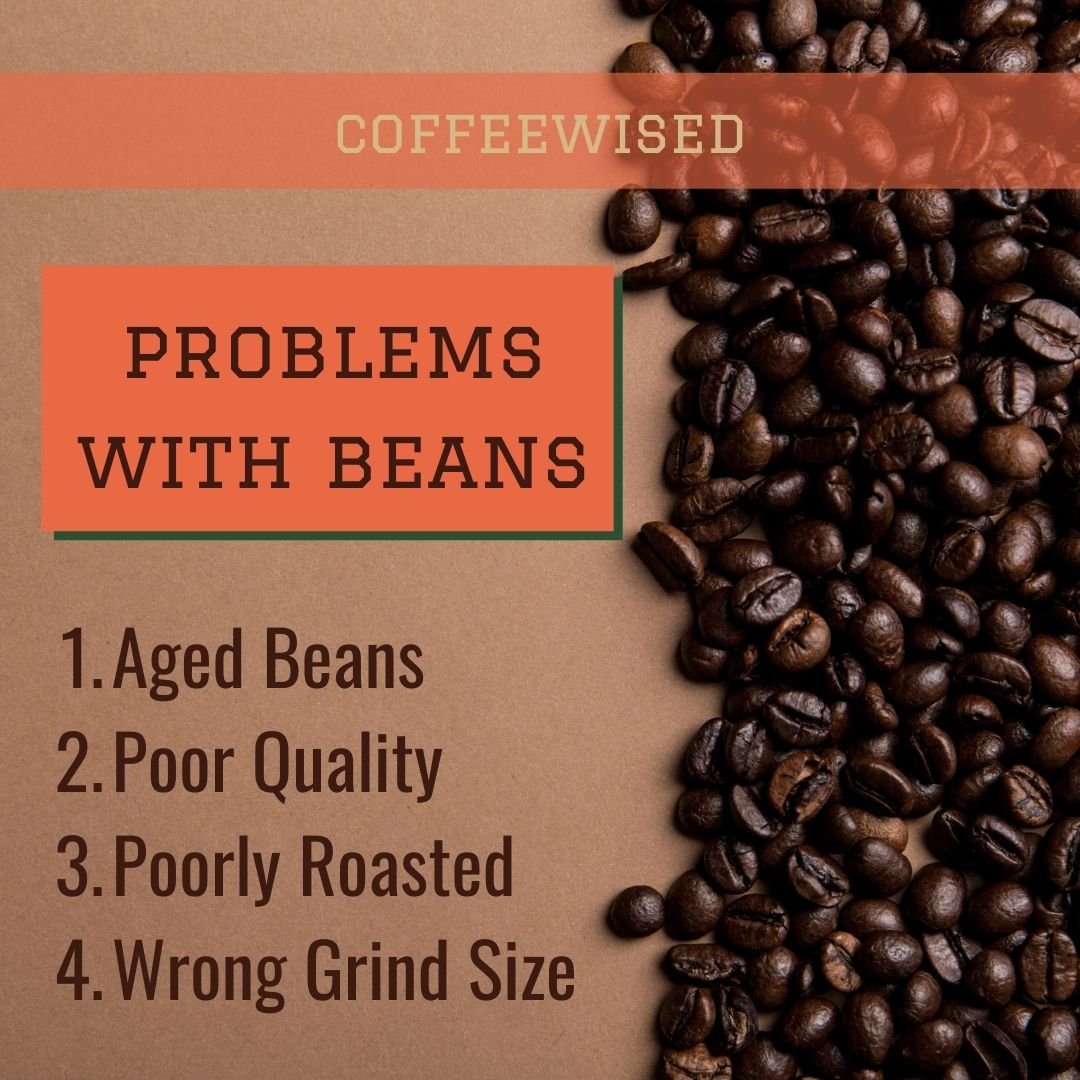
1. Aged Beans
Coffee beans do not last forever. It does not matter if there is an aluminum lining inside the pack, or the bottle has been sealed with XYZ technology, these beans lose their freshness over time.
Every 24 hours of air exposure sucks out at least 8% of coffee freshness. The reason is degassing. This is why, when you buy beans from display panels in the supermarket, chances are they have already lost 8% freshness at minimum.
Easy Fix
No, you don’t have to buy fresh beans every day. The trick is to buy beans from local roasters. Use Google Map or FaceBook (Meta) Marketplace to find local roasters in your area. Buy only one week of bean supply, and keep it in an airtight glass container. Avoid putting the jar near heat to maintain freshness. Open the jar only when you need, and then seal it back.
2. Poor Quality of Beans
Surprisingly, many commercial manufacturers do not use high-quality beans for their coffee. The instant coffee you buy from the supermarket aisle is mostly robusta coffee. It is cheaper and used in bulk manufacturing.
However, this does not mean that all commercial manufacturers use poor quality beans. So, how do you know if the coffee you use is of good quality? This How to Know Good Coffee Bean Quality guide has all the tricks you need to know.
You can know the poor quality of beans from the taste of coffee. When you take a sip and wonder why does my coffee taste bitter, that is when you can guess the quality of beans used. Many times, bitter-tasting coffee has a strong flavor but it’s not rich in flavor.
Easy Fix
If you want a richer flavor, use arabica coffee. Another technique is to check the cost of coffee. Unfortunately, good quality coffee is expensive. Although the cost is often a good indicator, sometimes it can get trickier too. That is when you can check reviews of the coffee online.
This fun video has lots of tips and tricks to find the best coffee beans, even if you have a crowd of beans to pick from.
3. Poorly Roasted Beans
Roasting is the defining part of the end product in the caffeine playground. Even if you roast the beans at home and miss out on that single important step, your coffee could be ruined.
During roasting, beans release oils that stick to the sides of the roasting machine. Some suppliers do not clean their roasting equipment after each batch, which may expose new beans to the old oils. It may also mix the beans. Another problem is storage. The beans must be stored right after roasting, otherwise the oxidation process starts which gives a stale flavor to coffee.
Easy Fix
A not-so-easy way is to roast your beans at home. Do not grind them after roasting to minimize the chances of oxidation. Grind them before each use. You can also roast a batch for 3-4 days and grind it to reduce the workload.
I will be honest, I buy freshly roasted bean supply for a week from a local roastery and keep half of them in an airtight jar. How do I store them? I grind the remaining half in a burr grinder for my daily French Press coffee. If I am using another equipment, I grind fresh beans of appropriate size for the equipment I am using.
An easy fix is again, to find a reliable local roastery and buy roasted beans from there, or choose a high quality arabica brand.
4. Using a Wrong Grind for Your Equipment
Under-extracted or over-extracted coffee is usually a result of the wrong choice of grind for your equipment. Sometimes, you may choose an appropriate grind for your available equipment, but the beans do not have consistency in the grind. Here is what goes wrong.
- When you want a bold flavor of coffee from an equipment that requires less brewing time, you will choose a fine grind.
- For a rich flavor of coffee while using an equipment that requires more brewing time, coarse grind is a better choice.
- Some equipment and techniques require something between coarse and fine grind.
Easy Fix
We cannot play around when it comes to the grind size and appropriate equipment. Can you make an espresso from the coarse grind? Of course not. After lots of trials, I made my own coffee grind size chart and pasted it over my coffee counter. Not a single coffee has gone bad ever since I rely on this chart.
Water
Water makes 90% of your coffee. Two factors are important here, the quality of water and its temperature.
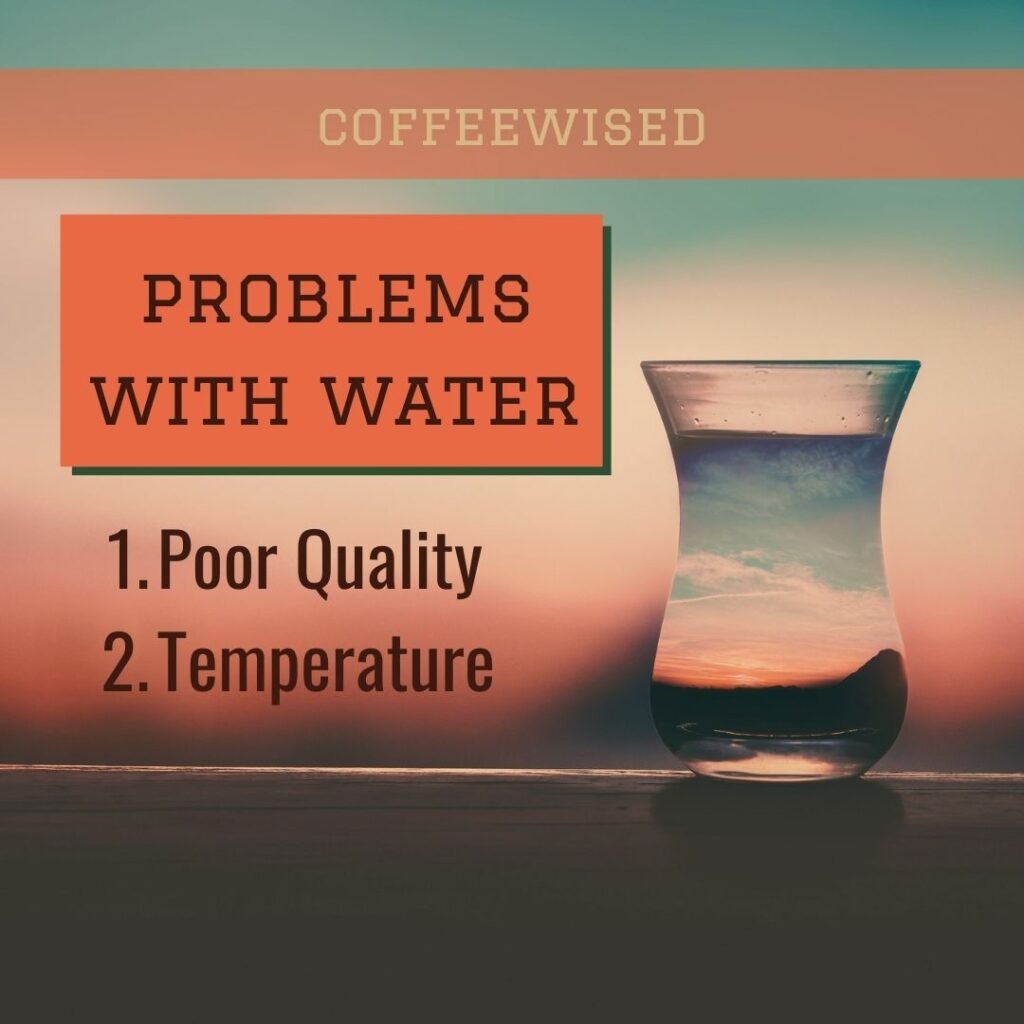
5. Quality of Water
A general rule is that any kind of water that is unsuitable for hair is unsuitable for coffee too. Hard water or unfiltered water is a big no-no. Some countries have a filtered tap water system, which is fine to use. However, if the supply lines have not been cleaned and there is mineral residue built-up, then this water is not suitable for your coffee.
Easy Fix
The ideal water for coffee is bottled spring water. You can also install a filter at home to make even tap water suitable for coffee.
6. Temperature of Water
Boiling hot water is the easiest way to ruin a cup of coffee. The temperature of the water when it touches the beans is very important. If the temperature is too hot, it will burn the beans, and they will also release oils. If the water temperature is too low, it will not pass through the beans properly. The result will be under-extracted coffee.
Easy Fix
The ideal water temperature for making coffee is 95 to 96 degrees Celsius. We don’t always use a thermometer in the kitchen, yeah? So, here is the trick. Bring water to boil, then turn off the flame and leave water covered for 30 seconds. Then use it.
Equipment
Coffee equipment can be tricky. From appropriate grind size to equipment handling, there is a lot to learn and remember.
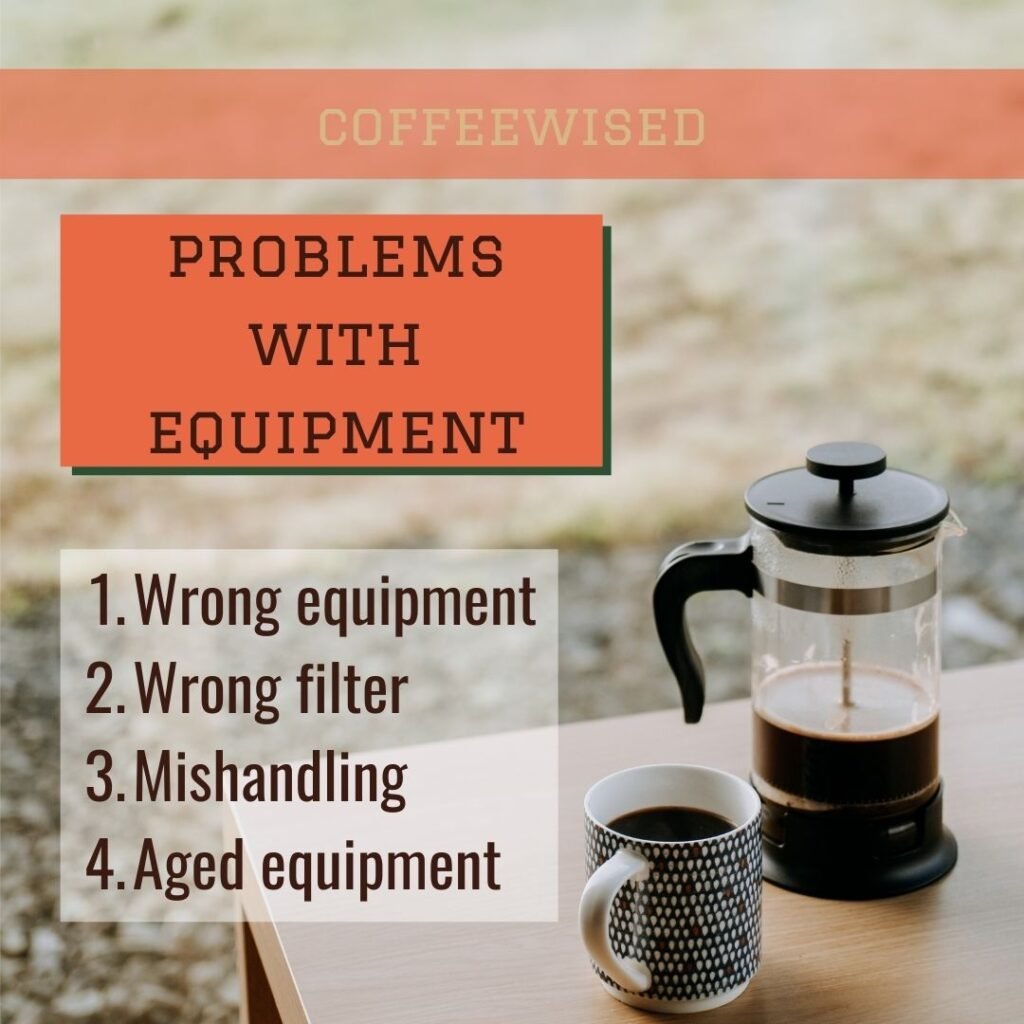
7. Wrong Equipment
The choice of equipment for a particular type of coffee is vital to yielding a good cup. We cannot make an espresso from a French Press. The coffee we yield from AeroPress and V60 is different from what we get from pour-over or drip.
Easy Fix
Many coffee equipments fall in the same type, like AeroPress and V60. However, the choice of filter and bean size will make a big difference in your yield. My Coffee Grind Size Chart has clear instructions about the appropriate grind size for each equipment.
8. Wrong Filter
Are you using a fine grind but your filter is appropriate for the coarse grind? You may get small coffee particles in your cup.
Easy Fix
Always pick an appropriate size of the filter according to your grind size. If you use the same type of equipment and grind size every day, then you can bulk buy reusable coffee filters to save the cost.
9. Mishandling of the Equipment
Limescale buildup is the most common issue in a poorly working coffee machine. It also leaves a muddy aftertaste. Apart from limescale, the coffee also deposits in the machine, which means that your today’s cup has leftovers from weeks ago coffee, if not years ago.
Easy Fix
Using bottled spring water will minimize limescale buildup in your equipment. But you still have to clean it with a process called descaling.
10. Aged Equipment
Everyone gets old, including the equipment on our coffee counter. Over the years, there is inner wear and tear, limescale buildup, poor filters, inefficient pipes, etc. Simply, your equipment starts to brew poorly.
Easy Fix
You can try getting your coffee equipment fixed by an expert. Simpler equipment like French Press can be fixed at home too. Otherwise, invest in a new coffee machine. What’s better than having a new queen home?
Technique
Each equipment and grind size requires a specific method. Small mistakes can leave you with a bad tasting coffee.
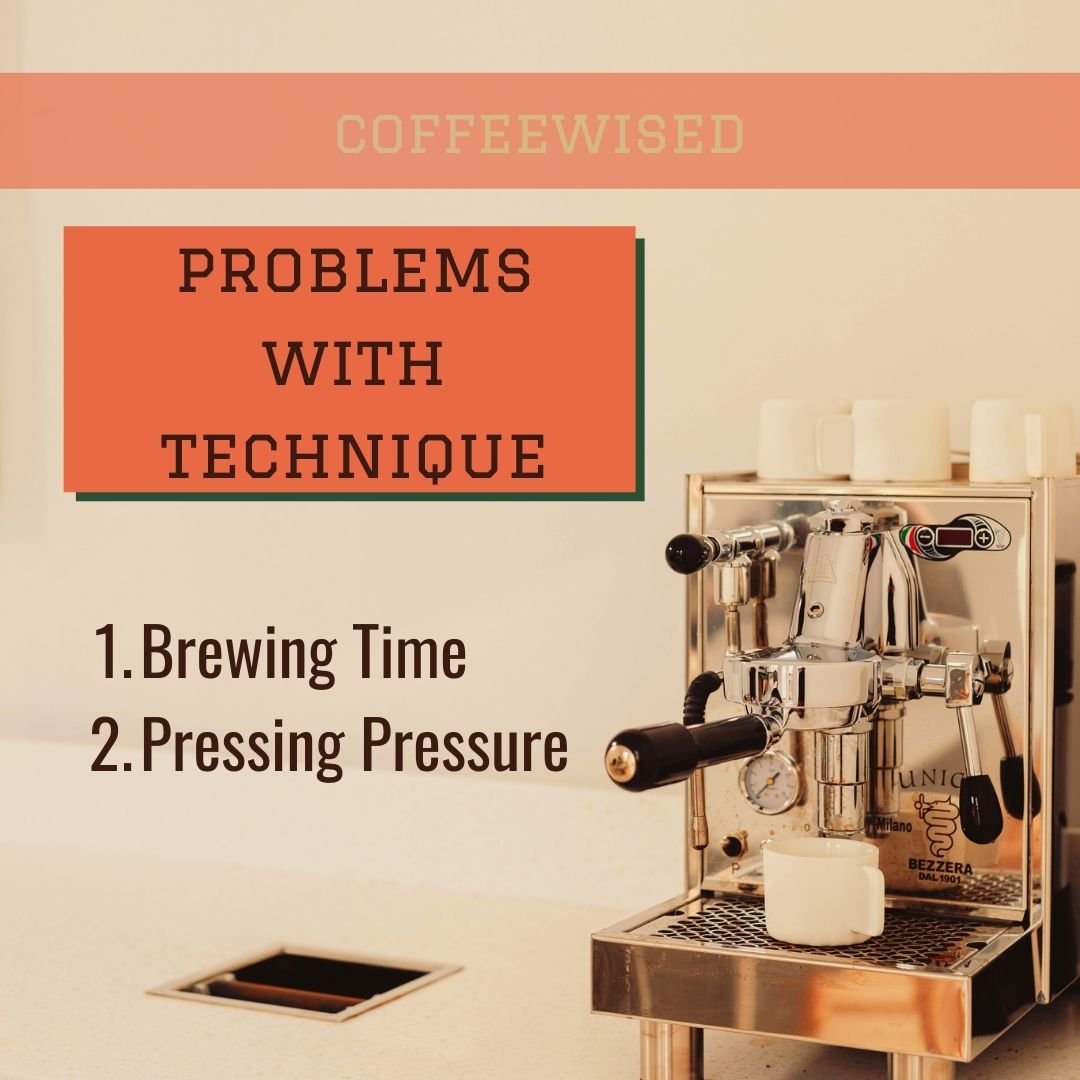
11. Brewing Time
Espresso drinkers have the benefit of using espresso machines or store-bought espresso sachets. For classic coffee drinkers, brewing time is crucial. If you pour coffee into the cup too early, you will have under-extracted coffee. If you let coffee brew for longer, you will have over-extracted coffee.
Easy Fix
Each coffee style has a unique brewing time. For French Press, pour-over and drip coffee, start with 3 minutes and work up to 4 minutes to find the right balance. For cold brew, anything between 18-24 hours will have the perfect taste. More than 24 hours will leave you with a bitter cold brew. For AeroPress and V60, 2 minutes 40 seconds is a good starter brewing time.
12. Pressing Pressure
When we press to extract coffee, we feel resistance. This resistance determines how much we need to press. If the resistance is too much, it means you are putting unwanted pressure for extraction. This will leave you with overly extracted coffee, and you may get small coffee particles too.
Easy Fix
Keep an eye on the resistance of the equipment. The resistance should not be too light or too hard against pressure.
Other Reasons of Why Your Coffee Tastes Bad
There could be many reasons your coffee tastes bad. Sometimes, it is not the beans or water, or the equipment. If none of the abovementioned reasons are helping, have a look at these ones.
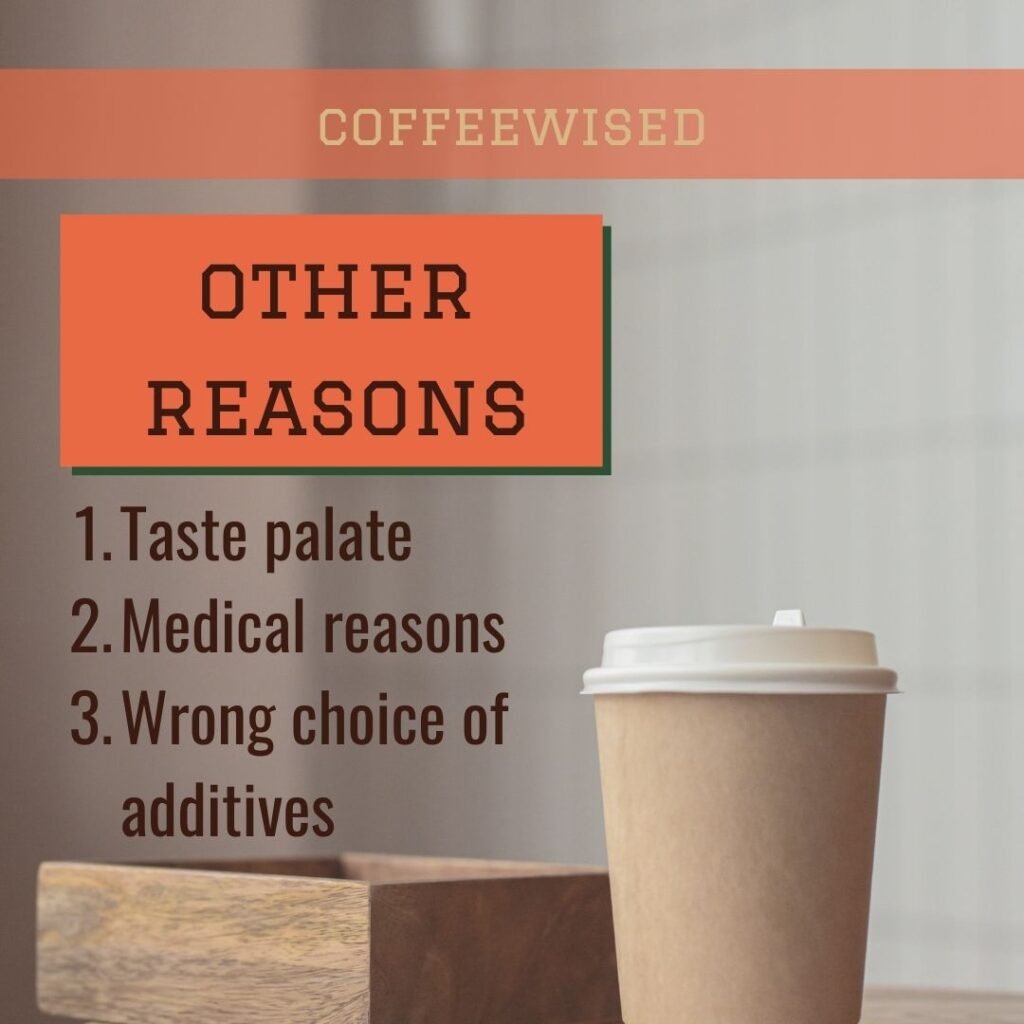
13. Taste Palate
The coffee palate is probably the widest palate in all types of foods and drinks. Some coffee might have gone viral on social media, but you did not like it. In my case, I did not like Dalgona coffee, but I love Dalgona candy.
Many times, it is not the type of coffee but how someone prepares it. You may not like the city’s most popular coffee but may love the coffee from the café at the corner of your street.
Easy Fix
If you are making coffee at home, the easy way out is to keep all variables consistent and change only one variable. For example, you can use the same equipment, same brewing time, and same amount of water, but change the quantity of beans to find a ratio that suits your palate.
14. Wrong Choice of Milk/Creamer/Sweetener
Some coffees require 2% full-fat milk, while others can do well with low-fat milk too. The same goes for creamers and sweeteners also. Many times, the coffee tastes bad when we use substitutes of dairy milk and creamer, and sweeteners. It is because our palate is not developed for non-dairy substitutes. If you are trying to go dairy-free, then it will take some time to build your palate.
Easy Fix
If you are not concerned about dairy or non-dairy milk, creamer, and sweetener, then you can try two options. Either change the fat percent you are using in your coffee or change your current brand.
15. Medical Reasons
Some medical causes, such as respiratory problems can cause a difference in your smell and taste. This can affect your general palate for all foods and drinks, including coffee. If you suddenly do not like the taste of your coffee and the taste of some other drinks or foods also, then look out for medical causes. It is very rare though that these medical causes change your palate for a specific food or drink only.
Coffee Tastes Bad After COVID
According to BBC, parosmia is the loss of taste and smell post-COVID for an elongated period. Even after 10 months, people are still waiting for their taste and smell to return.
The smell and taste senses take around six weeks to return after COVID. However, if someone is suffering from parosmia, they may feel like drinking hot water instead of a cup of espresso. It is surely frustrating. Sometimes, another kind of smell may replace the original smell and taste. Your morning French Press may smell like ashes or taste muddy every day.
Treatment
What could be more frustrating than not being able to smell your beautiful coffee every day? According to researchers, smell therapy may help with sensory recovery post-COVID, but it is not a sure-shot treatment.
FAQs – Why Your Coffee Tastes Bad
Now that we know 15 reasons your coffee tastes bad, let’s look into different tastes of coffee that fall in the unpleasant category.
Why Does My Coffee Taste Like Water?
Coffee tastes watery when either it is under-extracted or you are using a light roast.
- One solution is to use the correct grind size for your equipment, brew it for recommended time, and pour into cup through suitable filter.
- If you have already tried this, then another solution is to choose a stronger roast next time.
Why My Coffee Taste Burnt?
Two reasons explain why your coffee tastes burnt.
- The beans were over-roasted. In this case, the only solution is to get another batch of freshly roasted beans.
- The water was at boiling temperature when you poured it over the beans, and it burnt the beans. For this, boil water, turn off the flame and leave it covered for 30 seconds. Then put it on your coffee beans.
Why My Coffee Taste Bitter?
Two reasons explain why your coffee tastes bitter. Either the beans are of low quality or you brewed coffee for a long time, longer than recommended. Commercially manufactured coffee from robusta beans or using dark roast can yield bitter coffee. For brewing time, it’s best to stick to 3-4 minutes brewing time, other than cold brew.
Why My Coffee Taste Sour?
Acidic coffee has a sour taste. Two reasons explain why your coffee tastes sour. Either the beans are over-roasted or the coffee is incorrectly brewed. To fix a sour-tasting cup, you can either add more hot water and a sweetener or use a fine grind next time.
Why My Coffee Tastes Metallic?
The metallic taste of coffee comes from various causes.
- Beans were poorly roasted. Replace the beans with ones from a reliable roastery.
- Coffee was brewed for long time. Reduce the brewing time while keeping the measurements of water and coffee consistent.
- Coffeemaker is leaching metal icons. Try descaling the coffeemaker.
- The water you use has high chloride content. Put a filter or use bottled spring water.
- There is limescale accumulation in the coffeemaker. Try descaling the equipment.
- Check any medicines if you are taking. It could be a reaction too.
Why My Coffee Tastes Like Soap?
A common cause of soapy coffee is water. Either the water is not hot enough or it did not get to spend enough time with the beans. The solution is to use water at 95-96 degrees Celsius and increase the brewing time, keeping the grind and quantity of beans the same.
Why Does My Coffee Taste Bad All of a Sudden?
If your coffee has started to taste bad all of a sudden then there could be various reasons.
- Your water filter needs to be changed.
- If you are using filter on tap water, then there could be limescale buildup in water pipes.
- Coffee beans were left exposed to air for long time.
- If you have started a new medicine, it could be a reaction to the medicine.
- People have experienced bad tasting coffee during and after COVID.
What Does Rancid Coffee Taste Like?
You can describe the taste of rancid coffee somewhere between dull to sour. The taste of rancid coffee mostly comes from beans that have gone bad. To check the beans, prepare a cup of coffee like you regularly do. Sip it to check the taste. If it is dull or sour taste, leave the cup for an hour, and check again after one hour. If it still tastes dull or sour then the beans have gone bad.
Why Does My Coffee Have a Weird Aftertaste?
Over-extraction causes a weird aftertaste of coffee. Using the wrong grind size, brewing for too long, using very hot water, and pressing too harshly can cause over-extraction. Start with using a fine grind. If it does not work, then reduce the brewing time.
Why Does My Coffee Taste Like Mud?
Many people with parosmia have described the taste of coffee as muddy. However, you may feel the taste of coffee as muddy if you use hard water or there is limescale buildup in water lines of coffeemaker.
My Keurig Coffee Does Not Taste Good Anymore
If you are wondering why your Keurig coffee does not taste good anymore, then check one of the following reasons.
- Check the filters if you need to change them.
- Descale your Keurig. Limescale buildup could be the reason.
- Check for wear and tear.
- If the model of Keurig is too old, then you might need to change the coffeemaker.
- If it is a new machine, run a water cycle before using.
What to Do with a Bad Tasting, Beyond-Fixing Coffee?
Some bad-tasting coffees cannot be fixed. If you have tried but been unsuccessful in fixing your bad tasting coffee, then there are a few steps to minimize food wastage.
- If it is a big batch, then prepare coffee and use it in the garden as fertilizer. You can prepare a big batch, refrigerate, and use it in the garden every week too.
- If it is a small batch and the coffee is not expired, then you can use it in your chocolate cookies, chocolate cakes, brownies, and any chocolate dessert.
Making coffee can be tricky, but no one should drink bad tasting coffee when there are many fixes. If your coffee tastes anything different than these, ask away, and I will surely come up with a fix to it.
